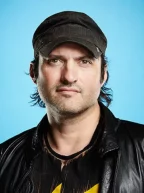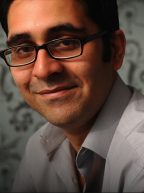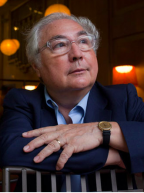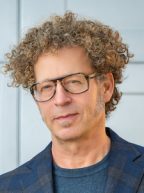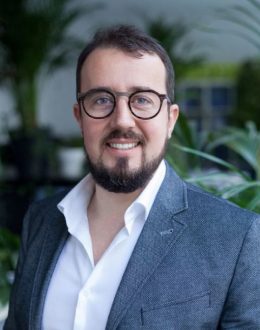
Vincent Callebaut keynote speaker
- Building through Biomimicry
- Fertile Cities
- The Secret of the Most Beautiful City of the World
- What Is an Archibiotic?
Awarded in the top 50 of the Green Planet Architects, Vincent Callebaut Architectures is referenced as the best eco-prospective and visionary architectural firm by the Time Magazine imagining fantastical projects that address the worlds environmental and social ills.
Belgian-born, Paris-based lead Archibiotect Vincent Callebaut designs and builds with the future in mind. Biomimetic and plus-energy buildings that produce their own power, vertical forests, pollution-removing towers and boats, floating cities and oceanscrapers, vertical food farms. Discover on his website projects that meet the major urban and ecological challenges of the 21st century.
Constantly challenging conventional ideas and pushing architectural boundaries, multiple award-winning Archibiotect, Vincent Callebaut has single-handedly spearheaded green and sustainable design, taking it to the next level.
Known for his ecovisions that surpasses the human imagination, his cutting-edge ideas give hope for a better future.
Armed with multiple successes and the determination to make a difference, he gathered a team of junior and senior experts that consisted of scientists, engineers and architects to help him on his mission to solve as many environmental and over population problems as possible.
Each of his green project showcases its green credentials in combining bioclimatic rules such as solar cycle and prevailing wind directions on the one hand, with renewable energy technologies in the form of wind turbines, thermal and photovoltaic solar energy, rainwater recycling, geothermal energy, biomass, up-cycling of biosourced material on the other hand.
With over 50 projects to his name, including several currently under construction, biomimicry specialist Vincent Callebaut is definitly an active proponent of people-oriented and environmentally-friendly architecture that ushers in new eco-lifestyles and new circular economy.
From then on, there was no stopping him from becoming the worlds leading visionary green architects. Callebaut began expanding his work outside of Brussels and Paris, spreading the gospel of sustainable and low carbon emission living as well as green architecture outside of Europe and across the African and Asian continents.
Among his most celebrated projects are the self sufficient amphibious city called Lilypad, a Floating Ecopolis for Climate Refugees - a long-term solution to rising water levels and the four challenges of climate, biodiversity, water, and health that was laid out by OECD - and Dragonfly, a Metabolic Eco-concept Farm for Urban Agriculture in New York City.
Like an unstoppable force, he then went on to create the award winning project Tao Zhu Yin Yuan Tower under construction in Taipei that received the International Architecture Award 2014 from the Chicago Athenaeum in New York. The same project also won the Highly Commended Award 2015 during the World Architecture Festival in the Future Residential Buildings category in Singapore. Another Asian project, the Asian Cairns, Sustainable Farmscrapers in Shenzhen was finalist for the Design German Awards 2014.
During the 2015 United Nations Climate Conference, he has planned for the Mayor of Paris City Hall the famous and ambitious project Paris Smart City 2050 to transform Paris from the City of Light into a green smart city and to aim at reducing 75% of the greenhouse gas emissions within 2050. Recently, one of his last project Aequorea, an oceanscraper 3D-printed with plastic trash receives the European Prize 2017 of Architecture Philippe Rotthier.
His profound vision has created awareness of the impending effect of climate change, opening up a profound possibility of a better future through sustainability designs.
The self-described "Archibiotect" discusses his work with CNN Style below.
Paris-based architect Vincent Callebaut wants his buildings to be more than your average tower block. His vision is ambitious : create an energy-saving, carbon-absorbing civilization to fight global warming.
I want to give hope for a better tomorrow, he says.
In 2050, we will be 9 billion human beings on our blue planet, and 80% of the world population will live in mega cities. It's time to take action against climate change, to invent new eco-responsible lifestyles and to incorporate nature into our cities. It's not a trend. It's a necessity! To think outside of the box, to shake up the old structures. To make society evolve is the most difficult thing to do in this world...but it is possible step by step.
Archibiotect is the new transdisciplinary approach invented by Vincent Callebaut in 2008.
Archibiotect is a word combining the prefixes of the words ARCHItecture + BIOtechnologies + Technologies of Information and Communication.
Whereas the primary reason of architecture has been to protect man against nature, the contemporary city strives to reconcile human beings and their natural ecosystems. The garden is no more placed side-by-side to the building; it is the building! The architecture becomes cultivable, edible and sustainable.
Outlandish and futuristic as they may seem, Vincent Callebaut says, the core of all my designs is an attempt to address the real threat that cities pose for humankind and our ecological balance.

